Gibson SG Best Years: Best and Worst Times

The best and worst times of Gibson SG guitars, which years to buy and which to avoid: qualities, specifications and features.
Table of Contents
Gibson SG: qualities and characteristics through the years
The SG is the best-selling guitar in the history of Gibson, the longest-established guitar maker. Furthermore, the SG electric guitar is also Gibson’s model produced continuously for the longest time. Its release was at the end of the year 1960, as a replacement and evolution of the Gibson Les Paul. In fact, it was released under the name Gibson Les Paul.
The Les Paul model suffered a drop in sales in the late 50’s due to its overly traditional and heavy design and its higher cost compared to other guitars on the market. Thus, the Gibson SG arises from the need to make a more modern, lightweight, ergonomic and also affordable guitar. As often happens with guitar models, the Gibson SG was having modifications though the years. The main one of these was the change of fit between the neck and body of the guitar.
If you want to know more, read the history of the Gibson SG guitar.

Best years and years to avoid for the Gibson SG
This review speaks in general terms, so it should not be generalized. In all ages you can find good Gibson SG guitars and others that are not. Here we express the quality of materials and manufacturing, and quality controls of each period. Thus, the periods where the best musical instruments are found are identified.
The analysis is based on the Gibson SG Standard, but the best years and the years to avoid can be projected to the rest of the models of SG guitars.
Period 1960-1966: The Golden Age of the Gibson SG
The best time is between 1960 and 1966, without a doubt they are the best years to buy a Gibson SG guitar. Gibson SGs that were made between the late 1960s and mid-1966 are the most sought-after guitars by collectors. This is the era when Gibson was under the leadership of the legendary Ted McCarty.
During these years the guitar is manufactured with a neckjoint that does not protrude from the body. This not only makes the neck a bit more brittle, it also gives it a leaner and more dynamic sound. The pickguard is smaller than the later ‘Batman’ or ‘Batwing’ pickguard. Also, during the early years the SGs had a slim neck. In 1964 SG Standard guitars began to have a profile similar to the 59, with a «C» type profile.
Within this Era there are different levels of preferences. Typically, the older, the more desired the guitars are. Thus, the Gibson SG Standard of 1960, 1961 and 1962 are the most sought after guitars to buy. These are the guitars that are still called “Les Paul.” The contract with Les Paul was for 10 years, and in 1962 the contract with the artist expired. The guitarist was going through a scandalous divorce process with Mary Ford. Faced with this situation, the artist agrees not to renew with Gibson until his situation is resolved. Thus, in 1963 the model took its current name “Gibson SG”, for “Solid Body”.
Thus, these guitars, although they are the most sought after, are also the most expensive of all. Below you can find a price guide for the Gibson SG Standard from 1960 to 1966.

1960-1966 Gibson SG Standard Prices
The prices listed below for Gibson SG Standard guitars made in 1960, 1961, 1962, 1963, 1964, 1965, and 1966 vary depending on the condition of the musical instrument. The price ranges listed below are the most common prices for Gibson SG Standard being bought and sold at for this period. But there are rare cases that go above or below the detailed price ranges.
- Gibson Les Paul / SG Standard 1960s and 1961s average $ 8,000 to $ 18,000, but can be priced more than $ 20,000. Thus, these are the most expensive years to buy a Gibson SG.
- Les Paul / SG Standard guitars from 1962 have an average price of between $ 6,000 and $ 16,000 and can also exceed $ 20,000.
- Gibson SG Standard guitars from 1963 typically have a price range of $ 5,000 to $ 12,000.
- Prices for Gibson SG Standard guitars from 1964, 1965 and 1966 range from $ 4,000 to $ 11,000.
Thus, as the years go by, the prices of the Gibson SG Standard go down.
Period 1966-1969: The first modifications to the SG
After the departure of Ted McCarty, at the end of 1966 the Gibson SG undergoes modifications. The body in the neckjoint area advances further over the neck and the neck is lengthened at the heel, to gain strength and prevent it from breaking. There is still a recess in the body in the neckjoint area. This lowering will disappear from 1969. In addition, this modification makes the SG guitar of these years gain more middle frequencies and have a fatter audio.

Another change made by Gibson in 1966 to the SG is the adoption of the “Batwing” or “Batman” pickguard to speed up the mounting of the pickups, taking the Fender model. This pickguard is larger and has a shape similar to a bat with its wings spread, which is why it is often called “Batman”.
This era, which runs from 1966 to 1969, and can even extend to mid-1971, is the second most sought-after era to buy for the Gibson SG. Although it is already undergoing modifications, the quality is still excellent. Thus, the Gibson SG of 1966, 1967, 1968 and 1969 are the second most sought after.

As in the previous period, better years can be highlighted. Thus the Gibson SG guitars from the late 1966 and 1967 are the most desired. Then the 1968 and 1969 Gibson SGs are a little less sought after, but also more affordable.
1966-1969 Gibson SG Standard Prices
Prices for Gibson SG Standard made in 1966, 1967, 1968, and 1969 vary depending on the condition of the musical instrument, the year, and the color of the finish. The price ranges listed below are the most common prices for Gibson SG Standard being bought and sold at for this period. But there are rare cases that can exceed or be below the detailed price ranges.
- Gibson SG Standard from late 1966 and 1967 have an average price between $ 3,000- $ 7,000.
- SG Standard guitars from 1968 and 1969 have an average price of between $ 3,000 and $ 5,000.
Period 1970-1985: The Norlin Era

At the end of 1969, an Ecuadorian company took control of Gibson, from this moment the Norlin Era began. The new shareholder had a proactive attitude and, seeking to solve problems and improve production processes, implemented what they considered “improvements.” Thus, a whole series of changes began in 1971 that seek to modernize processes, improve them and also make them cheaper. But these changes were not well received by Gibson’s customers. This is why this period is considered Gibson’s darkest, and guitar players usually avoid these years of Gibson.
To understand this era, we must consider that these are the years when competition from Asian guitars, especially Japanese, of good quality and very low prices, pressures not only Gibson, but all manufacturers to seek to reduce costs in order to compete.
Thus, throughout the Norlin period of the 70s and beyond, they tried to restructure the production processes and designs of guitars, such as the SG, to reduce costs. Thus, the guitars underwent modifications, and the quality of the workmanship dropped a lot, since it was intended to increase production. This means less work time for each guitar. In addition, new models were launched that were not successful, such as the Gibson SG-200.

Changes to the Gibson SG in the ’70s
Thus, in 1970 the necks began to be made of three pieces of mahogany and some made of maple. Gibson also begins to make a scroll around the neck to give it solidity. With this, Gibson sought to obtain more stability and thus improve the quality of the guitars. But these changes were a big disappointment for Gibson users. Also, to save time, recesses are reduced or eliminated. The lateral recesses of the body are reduced and that of the cutaway practically disappears, especially the upper one.

Then, in 1971, Gibson changed the neck fit of the SG guitar, so the neck was further inside the body. Thus, the bridge moves. The plastic piece between the neck and the pickup disappears. Also, rectangular inlays are being used instead of trapezoidal ones. In addition, the “harmonica” bridge is incorporated. It is so called because it is a block that resembles a harmonica. Finally, later this year, the original small pickguard is used again.
In 1979, the location of the Jack and Pickup Selector Switch was changed. The Jack is moved to the edge of the body like on a Les Paul guitar.

Gibson SG: years to avoid 1971-1985
Guitars from the 1970s are still appreciated, as the only significant change from the late 1960s is the 3-piece scrolled neck. But as the years go by and the modifications are made, they are less and less appreciated. Thus, Gibson SGs from 1971 onwards are the years to avoid, especially the period from 1979 to 1985 where the pickup selector and jack are located elsewhere.
1970-1985 Gibson SG Standard Prices
Prices for Gibson SG Standard guitars manufactured between 1970 and 1985 vary depending on the condition of the musical instrument, the year, and the color of the finish. The price ranges listed below are the most common prices for Gibson SG Standard being bought and sold at for this period. But there are rare cases that can exceed or be below the detailed price ranges.
- The Gibson SG Standard from 1970 are the most appreciated of the Norlin Era, since the neck still has the same placement as the guitars of the ’60s. These guitars are typically priced between $ 2,200 and $ 3,400.
- Guitars between 1971 and 1979 typically sell for between $ 1,100 and $ 2,000. As they get older they are more sought after and more expensive.
- SG Standard guitars from 1980 to 1985 have an average price of between $ 1,000 and $ 1,600.
Thus, as the years go by, the prices of the Gibson SG Standard of these years go down.
Period 1986-1999: Return to the roots and improve the quality

In 1986 Norlin sold Gibson to Henry Juszkievicz and David Berryman, the new owners came to change things. Between 1986 and 1999 Gibson concentrated on improving the quality of its musical instruments. In this period, greater quality controls are implemented. To these improvements are also added the use of better woods and finishes.
In the late 1980s, Gibson began to define models based on classic specifications. Thus, Gibson began his path to what most lovers of the brand considered the “correct” way to make their traditional guitars. In 1986, the Gibson Les Paul 1961 Reissue was released with original specifications. In addition, at the end of 1989 the original location of the neck was resumed and the Pickguard “Batman” or “Batwing” was used again.
To achieve better quality, the company restructures itself, reducing itself and taking a more manageable size, achieving greater control of what it manufactures. Cheap guitars are being manufactured in Asia under the Epiphone brand of guitars.
Thus, from the mid-80’s a rebuilding of the brand begins in which good models can be found, especially from the 90’s. In fact, the period from 1990 to 1996 is considered a modern golden age for Gibson guitars. Thus, 1990 to 1996 years are great to buy a Gibson SG.
1986-1999 Gibson SG Standard Prices
Prices for Gibson SG Standard guitars made between 1986 and 1999 vary depending on the condition of the musical instrument and the color of the finish. The price ranges listed below are the most common prices for Gibson SG Standard being bought and sold at for this period. But there are rare cases that can exceed or be below the detailed price ranges.
Gibson SG Standard manufactured between 1986 and 1999 typically sell for between $ 800 and $ 1,600.
Period 2000-2006: Stability in quality
In this period, Gibson has already regained part of its lost trajectory in the Norlin years. Gibson SG models have the traditional specs that fans of the brand are fond of. Thus, Gibson’s production continues to grow, but there are no significant supply or quality problems.
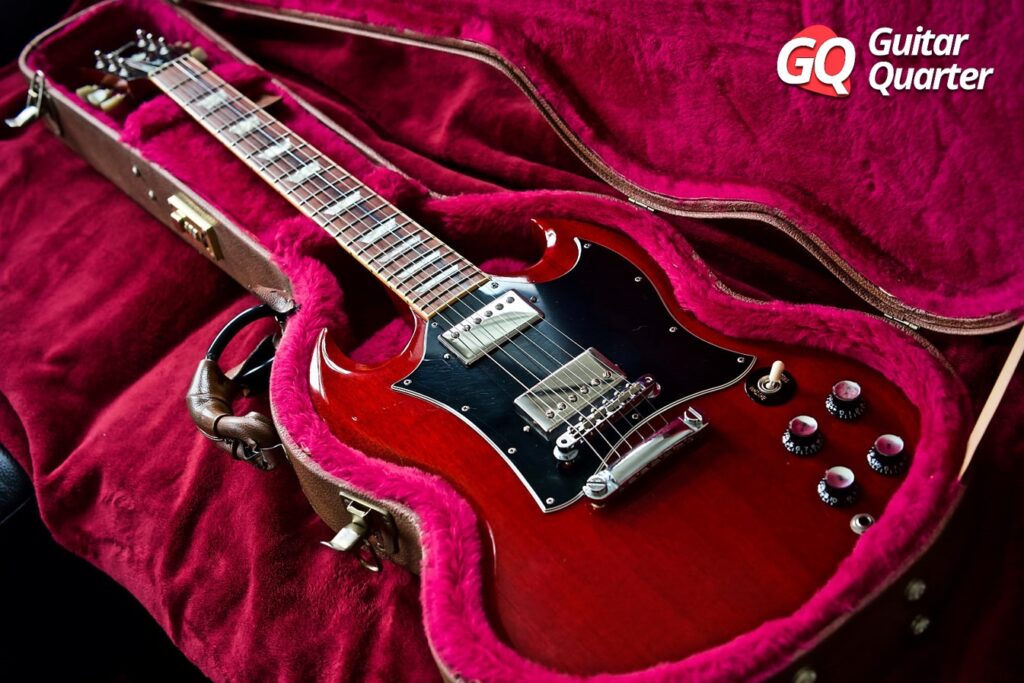
Gibson SG Standard 2000-2006 Prices
Prices for Gibson SG Standard guitars manufactured between 2000 and 2006 vary depending on the condition of the musical instrument and the color of the finish. The price ranges listed below are the most common prices for Gibson SG Standard being bought and sold at for this period. But there are rare cases that can exceed or be below the detailed price ranges.
Gibson SG Standard manufactured between 2000 and 2006 typically sell for between $ 700 and $ 1,100.
Period 2007-2012: Shortages and fall in quality
By early 2007, Gibson had grown quite large and was experiencing a shortage of rosewood and ebony tonewoods. What ends up impacting the quality of the woods used in the guitars. The quality of the instruments is varied, as the Company does not obtain a sufficient quantity and quality of tonewoods for all the guitars it produces.

Quality issues are compounded in the three years from 2010 to 2012. Gibson is forced to use alternate wood and laminate fingerboards, higher-part bodies, and lower-quality, heavier mahogany. Which is why these Gibson SG years are often avoided.
Gibson SG Standard 2007-2012 Pricing
Prices for Gibson SG Standard guitars manufactured between 2007 and 2012 vary depending on the condition of the musical instrument and the color of the finish. The price ranges listed below are the most common prices for Gibson SG Standard being bought and sold at for this period. But there are rare cases that can exceed or be below the detailed price ranges.
Gibson SG Standard made between 2007 and 2012 typically sell for between $ 700 and $ 1,000.
2013-2021 period: Gibson SG today
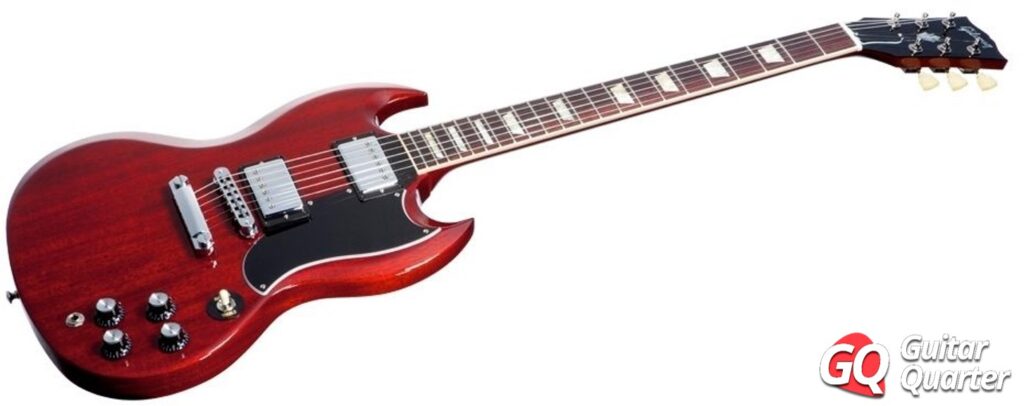
Starting in 2013, Gibson solves its supply problems. In addition, it begins to use different qualities of mahogany but with an effective selection process. Thus, the tonewood is assigned according to the model level. Thus, the tonewood and construction quality is consistent.
The 2015 Gibson SG guitars come with a wider fingerboard for more extreme vibrato. Some models also incorporate adjustable bronze nut, do not have the traditional Nibs and are equipped with G-Force. For Gibson purists, 2015 is not a good year for these modifications, which is why they avoid the 2015 Gibson guitars.
As of 2016, Gibson returned to the “tradition”, and improving the specifications towards the classic ones. With an emphasis on the «Historic» models for the more expensive lines and the standard models are classified by decade. That is, the lines are focused on the tradition and classical times of Gibson guitars. The current years are already considered by many to be the best for the higher lines of Gibson guitars.
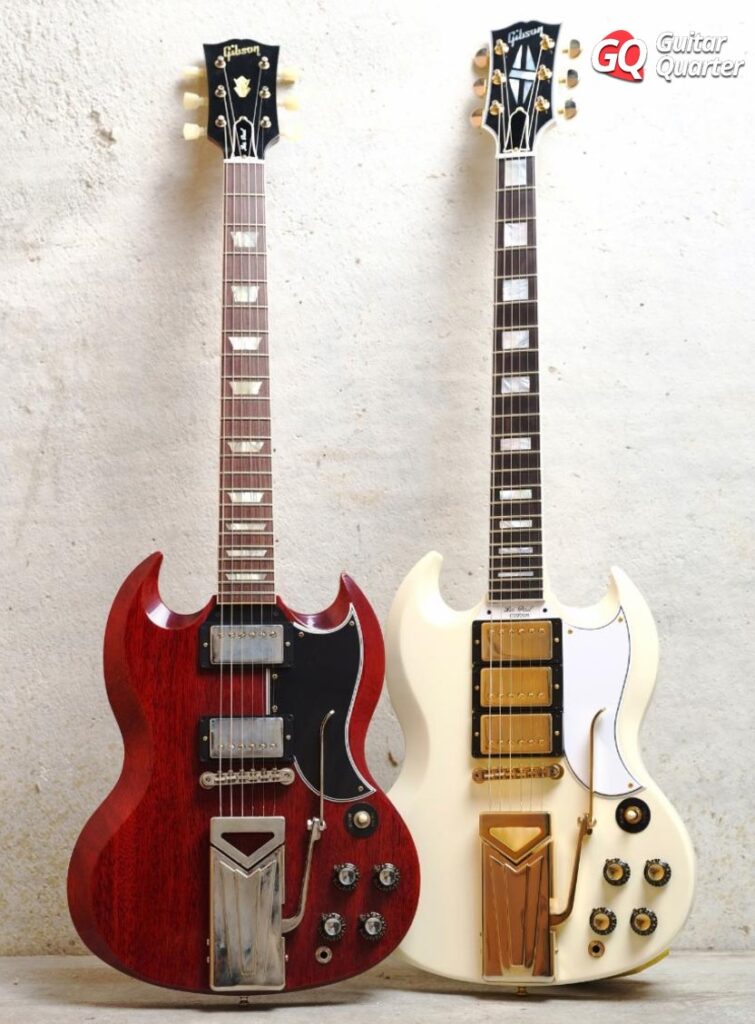
Gibson SG Standard Prices 20013-Present
Prices for Gibson SG Standard guitars manufactured between 2013 and the present tend to be in the range of Gibson SG Standard guitars manufactured between 2013 and the present usually sell for between US $ 800 and US $ 1,500.
What is your favorite time in relation to the price quality of the Gibson SG? What years of Gibson SG do you avoid when buying? What are the best years of the Gibson SG for you? Tell us about your experiences in the Comments section.



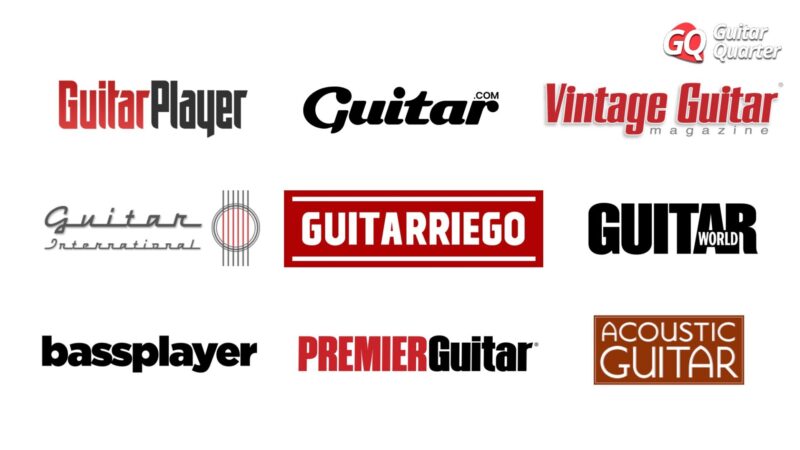


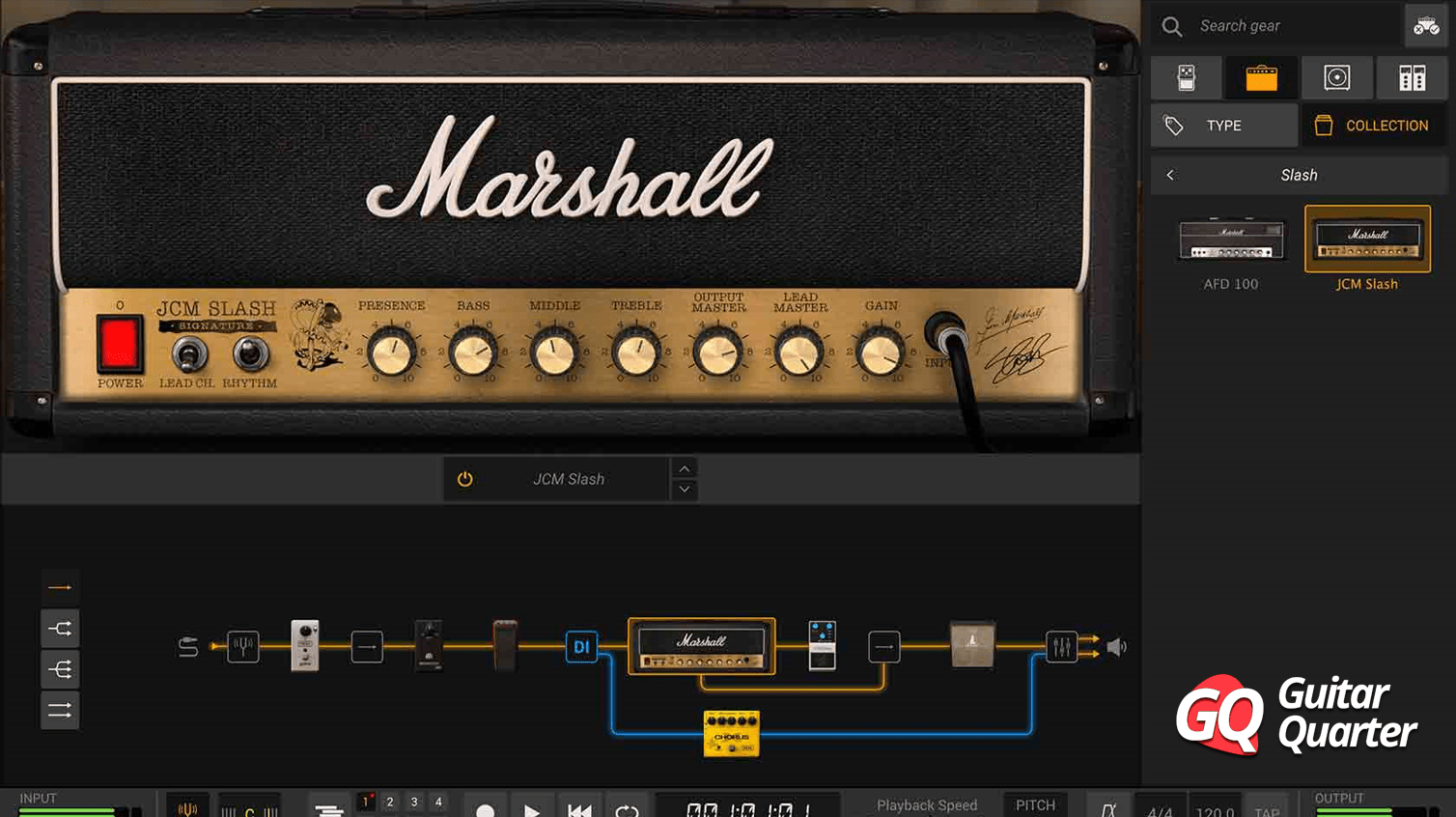
hi , very interesting site about Gibson guitars which I like very much as a matter of fact my second guitar that I bought was a Gibson SG standard way back in early 1974, it has an ebony finger board and Patent Number humbuckers been using it all these years and still all original including frets, but sorry to say that I don`t agree that they have to be avoided , I know a few of my friends who own much later dates SG which don`t sound so good as mine plus they have already done refrets on them. Thanks
Hi Raymond, thanks for your comment. Glad to know that your 1974 sounds good! The article is a guide about specs, characteristics and average quality of each time. In the 70’s the japanese competition was tough for all the american builders, Gibson and Fender both suffered it, it is not a mere coincidence that for both most important builder the 70’s was a “bad time”. They cut costs in order to compete with cheap but good quality guitars. But we don’t mean that every single guitar of the 70’s are bad, no doubt that there are good and bad guitar in each time, but generally speaking, there were better a worse times.
I have owned a number of SG’s from the mid late 60’s to the early 1980’s. The only example I have kept all these years and by far the best player was a 1982 SG standard that I put EMF active pickups in around 1987. It has the best, fastest neck of any SG I have ever handled.